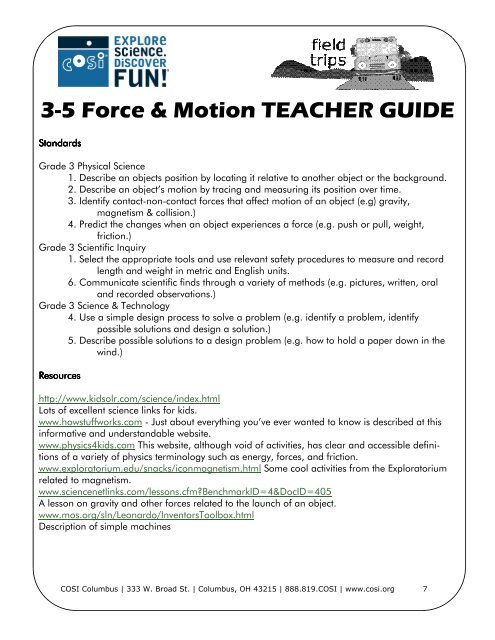3-5 Force & Motion TEACHER GUIDE - COSI
3-5 Force & Motion TEACHER GUIDE - COSI 3-5 Force & Motion TEACHER GUIDE - COSI
3-5 Force & Motion TEACHER GUIDEVocabulary WordsThese are some Force & Motion terms that you should be familiar with as you explore COSI withyour students:• Force: A push or pull on an object. You can observe a force when something flies, falls, spins,drops, rolls or stops.• Gravity: The earth’s pull on things.• Mass: A measure of quantity of matter in an object.• Newton’s First Law of Motion- An object in motion will stay in motion unless acted upon by anoutside force, or things will keep on doing what they are doing until something stops them.This is also known as inertia.• Newton’s Second Law of Motion: Force =Mass x acceleration, which translates to this: themore mass an object has, the more you have to push it. The harder you push an object, thefarther it will go.• Newton’s Third Law of Motion: When you push on an object, it pushes back, and is often referredto as action and reaction. This is not the same as cause & effect.• Speed: how far something goes in a certain amount of time.• Velocity: How fast and in what direction something is going.• Weight: The amount of gravitational pull on an object.Process Skills are the actions that it takes to “do science.” These are some of the scientific processskills that your students will be using as they explore the exhibits at COSI.• Observe - Use your senses to gather information.• Measure- Use tools and numbers to quantify objects or phenomena.• Categorize - Place objects into groups based on similarities or differences.• Communicate - Use words, pictures, graphs and diagrams to share your ideas.• Investigate - Follow a scientific method to formulate questions, conduct an experiment.• Apply - Put the information you’ve gathered to use.• Infer – Make an assumption based on your observations.• Question – Wonder and ask about things and find ways to discover answers.• Predict - Decide what will happen in the future based on your observations.COSI Columbus | 333 W. Broad St. | Columbus, OH 43215 | 888.819.COSI | www.cosi.org 6
3-5 Force & Motion TEACHER GUIDEStandardsGrade 3 Physical Science1. Describe an objects position by locating it relative to another object or the background.2. Describe an object’s motion by tracing and measuring its position over time.3. Identify contact-non-contact forces that affect motion of an object (e.g) gravity,magnetism & collision.)4. Predict the changes when an object experiences a force (e.g. push or pull, weight,friction.)Grade 3 Scientific Inquiry1. Select the appropriate tools and use relevant safety procedures to measure and recordlength and weight in metric and English units.6. Communicate scientific finds through a variety of methods (e.g. pictures, written, oraland recorded observations.)Grade 3 Science & Technology4. Use a simple design process to solve a problem (e.g. identify a problem, identifypossible solutions and design a solution.)5. Describe possible solutions to a design problem (e.g. how to hold a paper down in thewind.)Resourceshttp://www.kidsolr.com/science/index.htmlLots of excellent science links for kids.www.howstuffworks.com - Just about everything you’ve ever wanted to know is described at thisinformative and understandable website.www.physics4kids.com This website, although void of activities, has clear and accessible definitionsof a variety of physics terminology such as energy, forces, and friction.www.exploratorium.edu/snacks/iconmagnetism.html Some cool activities from the Exploratoriumrelated to magnetism.www.sciencenetlinks.com/lessons.cfm?BenchmarkID=4&DocID=405A lesson on gravity and other forces related to the launch of an object.www.mos.org/sln/Leonardo/InventorsToolbox.htmlDescription of simple machinesCOSI Columbus | 333 W. Broad St. | Columbus, OH 43215 | 888.819.COSI | www.cosi.org 7
- Page 1: 3-5 Force & Motion TEACHER GUIDEHow
- Page 4 and 5: 3-5 Force & Motion TEACHER GUIDEGAD
- Page 8 and 9: 3-5 Force & Motion TEACHER GUIDECla
3-5 <strong>Force</strong> & <strong>Motion</strong> <strong>TEACHER</strong> <strong>GUIDE</strong>StandardsGrade 3 Physical Science1. Describe an objects position by locating it relative to another object or the background.2. Describe an object’s motion by tracing and measuring its position over time.3. Identify contact-non-contact forces that affect motion of an object (e.g) gravity,magnetism & collision.)4. Predict the changes when an object experiences a force (e.g. push or pull, weight,friction.)Grade 3 Scientific Inquiry1. Select the appropriate tools and use relevant safety procedures to measure and recordlength and weight in metric and English units.6. Communicate scientific finds through a variety of methods (e.g. pictures, written, oraland recorded observations.)Grade 3 Science & Technology4. Use a simple design process to solve a problem (e.g. identify a problem, identifypossible solutions and design a solution.)5. Describe possible solutions to a design problem (e.g. how to hold a paper down in thewind.)Resourceshttp://www.kidsolr.com/science/index.htmlLots of excellent science links for kids.www.howstuffworks.com - Just about everything you’ve ever wanted to know is described at thisinformative and understandable website.www.physics4kids.com This website, although void of activities, has clear and accessible definitionsof a variety of physics terminology such as energy, forces, and friction.www.exploratorium.edu/snacks/iconmagnetism.html Some cool activities from the Exploratoriumrelated to magnetism.www.sciencenetlinks.com/lessons.cfm?BenchmarkID=4&DocID=405A lesson on gravity and other forces related to the launch of an object.www.mos.org/sln/Leonardo/InventorsToolbox.htmlDescription of simple machines<strong>COSI</strong> Columbus | 333 W. Broad St. | Columbus, OH 43215 | 888.819.<strong>COSI</strong> | www.cosi.org 7



